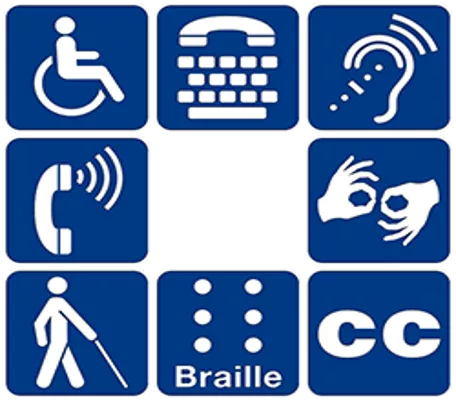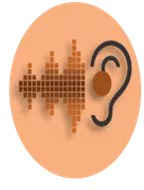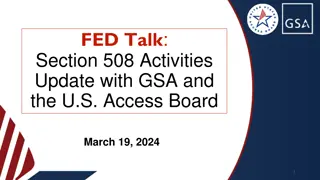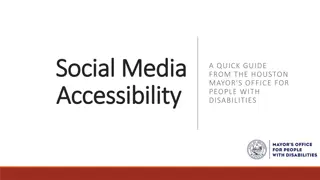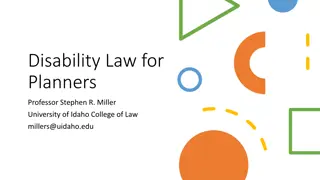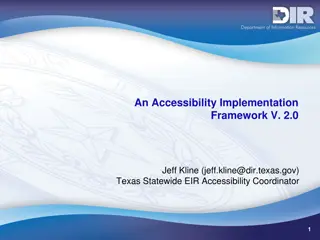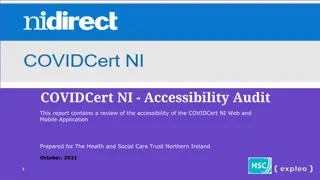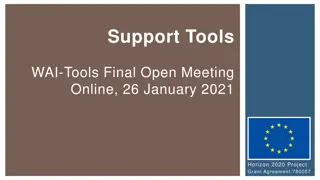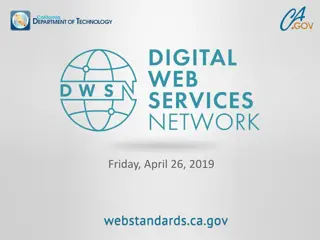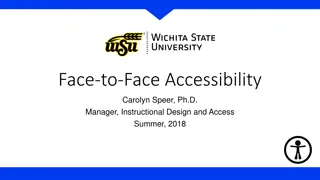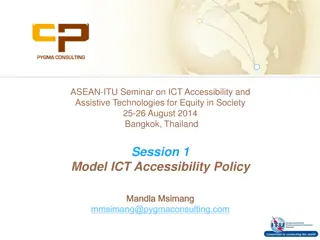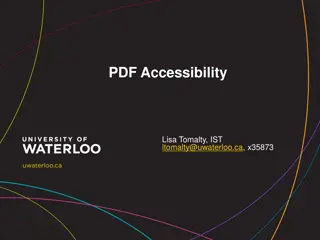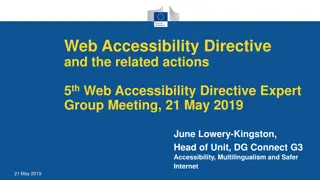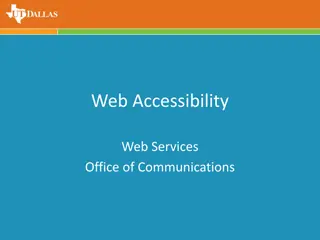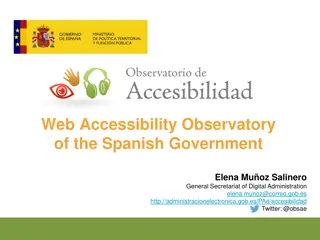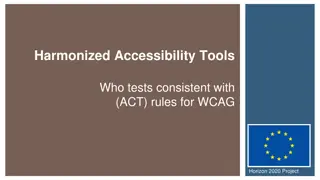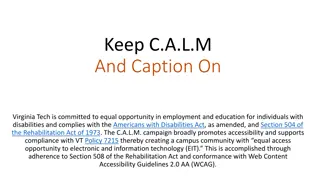Accessibility Laws & Health Plans Overview
The impact of accessibility laws on health plans, including the Americans with Disabilities Act and Affordable Care Act. Learn about assistive technologies, website accessibility, and COVID-19's influence on ensuring access for individuals with disabilities.
Download Presentation

Please find below an Image/Link to download the presentation.
The content on the website is provided AS IS for your information and personal use only. It may not be sold, licensed, or shared on other websites without obtaining consent from the author.If you encounter any issues during the download, it is possible that the publisher has removed the file from their server.
You are allowed to download the files provided on this website for personal or commercial use, subject to the condition that they are used lawfully. All files are the property of their respective owners.
The content on the website is provided AS IS for your information and personal use only. It may not be sold, licensed, or shared on other websites without obtaining consent from the author.
E N D
Presentation Transcript
Accessibility Laws and How They Apply to Health Plans 2021 Jacobus tenBroek Disability Law Symposium Morissa S. Fregeau Senior Associate Counsel Aflac The material discussed in this presentation is intended for general information purposes only and should not be construed as legal advice. All opinions stated are the presenter s and not her employer.
Removing Barriers 1 in 5 persons in the U.S. has a disability - U.S. Census 2010 Auditory Visual Cognitive Dexterity 2
Assistive Technologies Alternative Keyboard Screen Reader A Screen Magnifier [ABC] Voice Control Closed Captioned Alternative Pointing Device 3
What Needs to be Accessible? Website and Devices Video Documents 4
Who is responsible for Accessibility? Content author Graphic designer IT developer Interactive designer Business owner All of the above 5
The Law Americans with Disabilities Act Rehabilitation Act of 1973 Affordable Care Act Medicaid Managed Care Rule 6
And then there was COVID COVID brought an even greater need to ensure that individuals with disabilities had access to what was necessary during the pandemic. HHS issued a memo March 28, 2020 telling providers that all emergency messaging needed to be available in multiple formats addressing individuals with disabilities and reinforced that services needed to provide effective communication with individuals who are deaf, hard of hearing, blind, have low vision, or have speech disabilities through the use of qualified interpreters, picture boards, and other means. Martinez v. Cuomo decided May 12, 2020 ordering that all televised Corona Virus updates include an ASL interpreter. 8
How laws relate to Websites and Mobile Application Phone Verbal Communication Written Communication 9
Websites and Mobile Applications Websites will be accessible to individuals with disabilities. For whom? Members, enrollees and members of the public. What? Everything on website. 10
What is the standard? WCAG 2.0 Web Content Accessibility Guidelines (WCAG) World Wide Web Consortium (W3C) Internationally recognized Standard most often identified - WCAG 2.0 level AA WCAG 2.1 was published 6/19, but no update in law. What happens with 3.0? 11
Where does the standard come from? Public entities that choose to provide services through web- based applications or that communicate with their constituents or provide information through the Internet must ensure that individuals with disabilities have equal access to such services. 28 CFR Part 35 Appendix
ADA Title III, Regulations 28 CFR 36.303 Auxiliary aids and services. (a) General. A public accommodation shall take those steps that may be necessary to ensure that no individual with a disability is excluded, denied services, segregated or otherwise treated differently than other individuals because of the absence of auxiliary aids and services, 13
Affordable Care Act Section 1557 A covered entity shall take appropriate steps to ensure that communications with individuals with disabilities are as effective as communications with others in health programs and activities. Definition of disability is taken from the ADA 14
Rehabilitation Act Section 502 creates the Access Board. This board is tasked with determining technical guidelines for architecture, phone and electronic information technology (EIT) (EIT is now ICT or Information and Communication Technology). Section 504 creates the obligation for government agencies and companies receiving federal financial assistance to comply with accessibility standards. Section 508, amends the Act in 1986 to address accessibility for information and communication technology ("ICT"). Section 508 mandates that Federal agencies, "develop, procure, maintain or use ICT in a manner that ensures Federal employees with disabilities have comparable access to, and use of, such information and data relative to other Federal employees." 38 CFR Parts 1193-4 The Access Board passed new guidelines that became effective March 20, 2017. These new guidelines established the standard of WCAG 2.0 15
How does the Rehabilitation Act Apply to Health Plans? Section 92.3 of Section 1557 references both Section 504 and 508 of the Rehabilitation Act. This section states that 1557 is not meant to limit or apply a lesser standard. Medicare Marketing Guide Must ensure that website complies with Section 508 of the Rehabilitation Act. Medicaid Managed Care Rule Definition of Readily Accessible. 16
Wellness Programs Title I of the ADA prohibits discrimination on the basis of disability in regard to employment compensation and other privileges of employment including fringe benefits available by virtue of employment, whether or not administered by the covered entity. . . . The ADA requires employers to provide reasonable accommodations (modifications or adjustments) to enable individuals with disabilities to have equal access to fringe benefits, such as general health and educational wellness programs, offered to individuals without disabilities. EEOC on 29 CFR Part 1630 Section 1630.14, A program satisfies this standard if it has a reasonable chance of improving the health of, or preventing disease in, participating employees, and it is not overly burdensome, is not a subterfuge for violating the ADA . An employer may not require participation in a wellness program. Wellness program must include accommodation, for example an interpreter or alternative format for materials or a waiver. 17
Phone Calling a health plan must be accessible to individuals with disabilities. 18
Section 1557 of the Affordable Care Act Effective Communication (45 CFR 92.202(a)), Communication with an individual with a disability needs to be as effective as communication with others. Auxiliary Aids (45 CFR 92.202(b)) Provide appropriate auxiliary aids and services where necessary to afford such persons an equal opportunity to benefit from the service in question. Updates in 2020 did not change these sections 19
ADA Title III, Regulations 28 CFR 35.161 Telecommunications. (c) A public entity shall respond to telephone calls from a telecommunications relay service established under Title IV of the ADA in the same manner that it responds to other telephone calls. 20
Telecommunications Relay Service How does Relay Service work? A Communication Assistant (CA) facilitates a call for an individual with a hearing or speech impairment. Text to voice Individual types, CA speaks Voice Carryover Individual speaks, CA translates and then types answer back. Speech to speech Individual speaks, CA translates. Shared non-English Language Services FCC requires relay service to have Spanish Speaking CAs. 21
Communication Assistant and HIPAA Using a Relay Service Communication Assistant does not violate HIPAA, and a disclosure form is not required. - FCC Public Notice DA 04-1716 Released: June 16, 2004 22
Moving beyond TTY FCC issued a final rule January 6, 2017, Transition from TTY to Real-Time Text Technology, to facilitate the transition from TTY to RTT. The rule is only applicable to telecommunications services and is available for all 711 operators since 6/30/2020 82 FR 7699 (1/23/2017) 23
Verbal Communication Sign Language Interpretation ADA - 28 CFR 35.160 (c) Also referenced for covered entity in Section 1557 An individual does not have to bring another individual to interpret for him or her. If individual brings someone to interpret, the entity can t rely on that person, except in an emergency. A minor child may not be relied on to interpret, unless there is an imminent threat to the safety of the individual and there is no interpreter available. 24
Video interpretation may be used Can the individual see the video? Must have dedicated high-speed connection An image large enough to display the interpreter's face, arms, hands Can the individual hear the video? Must have clear, audible transmission of voices. How quickly can the equipment be set up? 25
Written Communication Preferences Primary preference on ongoing basis A plan may require an individual to ask for alternative format. ID Cards For Provider 26
Possibilities with the Biden Administration Whitehouse.gov accessibility statement DOJ proposed regulations from Obama administration Renewed DOJ investigations Changes to the updates to Section 1557 27
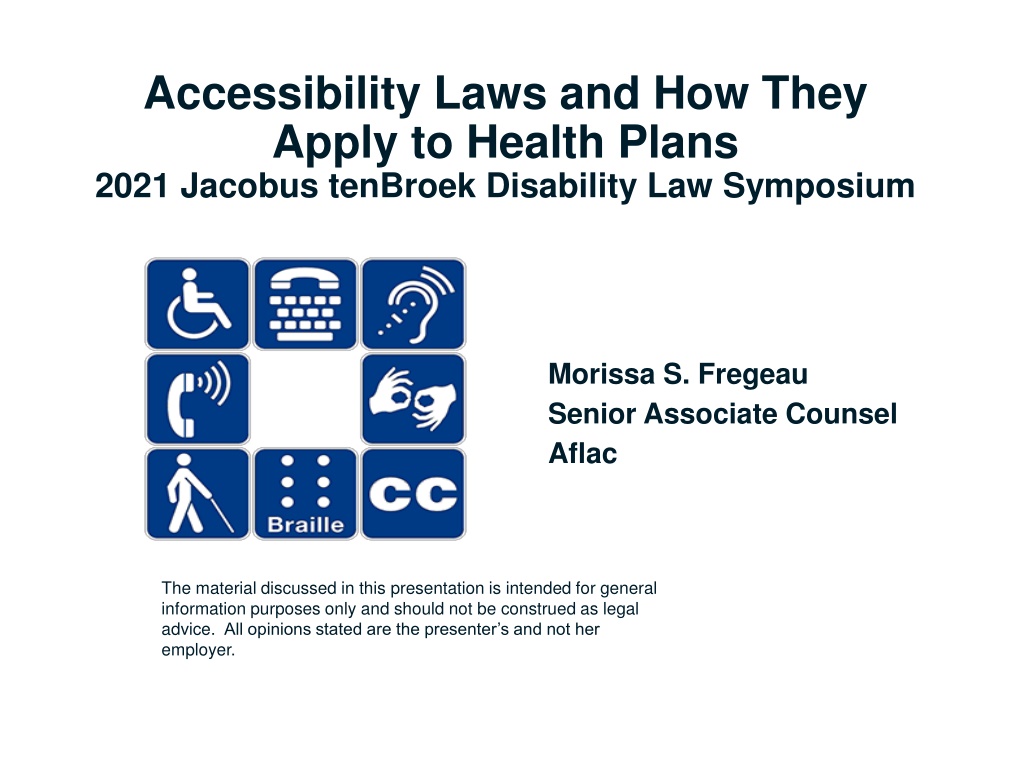
 undefined
undefined